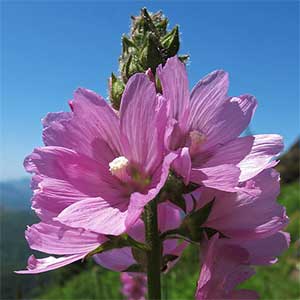Sidalcea hirtipes
Sidalcea gigantea
bluff mallow, bristly-stem checker-mallow, bristly-stem checkerbloom, hairy-stem checkermallow
giant checkerbloom
several, scattered, erect, arising from rhizome apices, usually slightly hollow, densely, harshly bristly-hirsute, hairs stiff, pustular, simple, forked, or stellate, often 2–2.5 mm.
single, scattered, erect, usually purple tinted proximally, hollow especially towards base, pithy distally, 10–14 mm diam. just distal to base, often glaucous, proximally densely retrorsely bristly-hairy and stellate-hairy, hairs pustulate, 1.5–2.5 mm, distally sometimes glabrous.
basal and cauline;
stipules linear-subulate, 6–8 × 1–1.5 mm;
petioles of proximal leaves 20–30 cm, 3 times as long as blades, reduced distally to 1/2 times as long as blades;
blades: basal and proximalmost orbiculate to reniform, shallowly 5–9-lobed, 10–15 × 10–15 cm, thick, base narrowly cordate, lobe margins coarsely crenate-dentate, apex rounded, surfaces coarsely hirsute, hairs stiff;
distal orbiculate, deeply palmately 5–7-lobed, incised ± to base, lobes sometimes lobed again, base cuneate, apex acute, deeply 2–3-toothed, surfaces long-hirsute or with 2–4-rayed, stellate hairs abaxially.
mostly cauline, basal usually absent;
stipules deciduous, with pink band on stem at base, narrowly lanceolate, (3.5–)5(–8) × 0.7(–1.5) mm;
petioles of proximal leaves 6–8 cm, those of midstem leaves 10–14 cm, 2 times to as long as blade, apex curved with swollen portion or pulvinus 5–6 × 1.8 mm;
blades of proximalmost cauline leaves rounded, shallowly, palmately 4- or 5-lobed, 0.5–0.7 × 0.5–0.7 cm, lobe margins irregularly, sparsely dentate, apices rounded, mid-cauline blades 5–7-lobed, 6.5–12 × 10–13 cm, wider than long, gradually reduced distally, lobes straplike, divided 3/4 to base, lobes 5.5 × 1.5–1.8 cm, margins coarsely dentate, surfaces sparsely, minutely hispid and stellate-puberulent, distal leaves deeply 5-lobed, otherwise similar in shape, leaves immediately below inflorescence greatly reduced, irregularly 2- or 3-lobed.
erect, spiciform to subcapitate, dense, calyces usually conspicuously overlapping in flower and sometimes in fruit, proximals usually long-pedunculate, unbranched or branched, 20+-flowered, 10+ flowers usually open on spike at same time, not interrupted, not 1-sided, usually to 8 cm, usually not elongate but sometimes slightly elongated in some populations and to 20 cm in fruit;
bracts paired or single, linear, distal undivided, proximal distinct to base, 6 mm, mostly slightly longer than pedicels.
erect, spiciform, open, calyces usually not overlapping, usually branched, branches 14–18 cm, each branch 10–20 flowered, not 1-sided, elongate, 5–20 cm;
bracts 1, usually undivided, narrowly lanceolate, often 2-fid, 2.5 mm, equaling or slightly longer than pedicel, much shorter than calyx.
1–3(–5) mm;
involucellar bractlets absent.
2–3(–5) mm;
involucellar bractlets absent.
bisexual or unisexual and pistillate, plants gynodioecious;
calyx often purple tinted, 9–11 mm, to 11–16 mm in fruit, margins ciliate, hairs 1–2 mm, surfaces finely stellate-hairy at base and with coarser, longer, simple and stellate hairs apically;
petals usually pale pink to rose-lavender, rarely white, slightly or not pale-veined, (9–)10–21 mm, pistillate often 9–14 mm;
staminal column 5–7(–10) mm, hairy;
anthers white;
stigmas 5–10.
bisexual or unisexual and pistillate, plants gynodioecious;
calyx 5–6 mm, to 8 mm in fruit, uniformly, densely stellate-puberulent, surface obscured;
petals pale pink, pale-veined, pistillate 7–9 mm, bisexual (10–)14–20(–25) mm;
staminal column 6–8 mm, stellate-puberulent;
anthers white to cream or pale yellow;
stigmas (6)7 or 8.
2.5–3.5 mm.
1.5 mm.
7–8 mm diam.;
mericarps 5–10, 3.5–4 mm, glabrous or sparsely stellate-puberulent, roughened, prominently reticulate-veined, sides rugose and pitted, back less so, mucro 0.6–0.8 mm.
6–7 mm diam.;
mericarps (6)7 or 8, sides 3 mm, thick, back and margins thick, rounded, reticulate-veined, pitted, back with prominent groove, top sparsely glandular-stellate-puberulent, mucro 1 mm.
= 60.
Sidalcea hirtipes
Sidalcea gigantea
Of conservation concern.
Sidalcea hirtipes is uncommon and known from Clatsop, Lincoln, and Tillamook counties in Oregon and Clark, Lewis, and Wahkiakum counties in Washington. Its elevation and habitat vary, and it seems as much at home on steep coastal cliffs as in more inland, historic prairies and mountain meadows. Populations can appear to be large because of the long-rhizomatous and clonal nature of the plants; they are few and local. It is threatened by grazing, loss of habitat, fire suppression, road construction and maintenance, and changes in hydrology. It is a candidate for listing in Oregon and has been listed as endangered in Washington. Sidalcea hirtipes is characterized by its coarse indument of bristle hairs, its generally compact spikelike inflorescences, its relatively few, large, erect, hirsute leaves, and, especially, its extensive, coarse rhizomes. The inflorescences in some populations are elongated in fruit; its range, hirsute indument, and thick leaves along with coarse rhizomes help to distinguish it from other species. Stem internode length varies depending on habitat, as in many other Sidalcea. Molecular data suggest a relationship among S. hirtipes and S. asprella, S. celata, and S. gigantea (K. Andreasen and B. G. Baldwin 2003).
(Discussion copyrighted by Flora of North America; reprinted with permission.)
Sidalcea gigantea is likely the tallest Sidalcea species; it can be distinguished also by its range (high Cascades and the northern high Sierra Nevada), retrorse hirsute stem bases, thick, hollow stems, and massive, hirsute rhizome systems. Most large patches appear to be clonal and generally produce either bisexual or unisexual, pistillate stems. Sidalcea gigantea is closely related to, and has been confused with, both S. asprella and S. celata. Its leaves are most like those of S. asprella in that they are usually similar in shape throughout the stem; the tall stems and massive rhizome systems distinguish it from S. asprella, as do its occurrence at higher elevations and its later flowering time.
(Discussion copyrighted by Flora of North America; reprinted with permission.)


